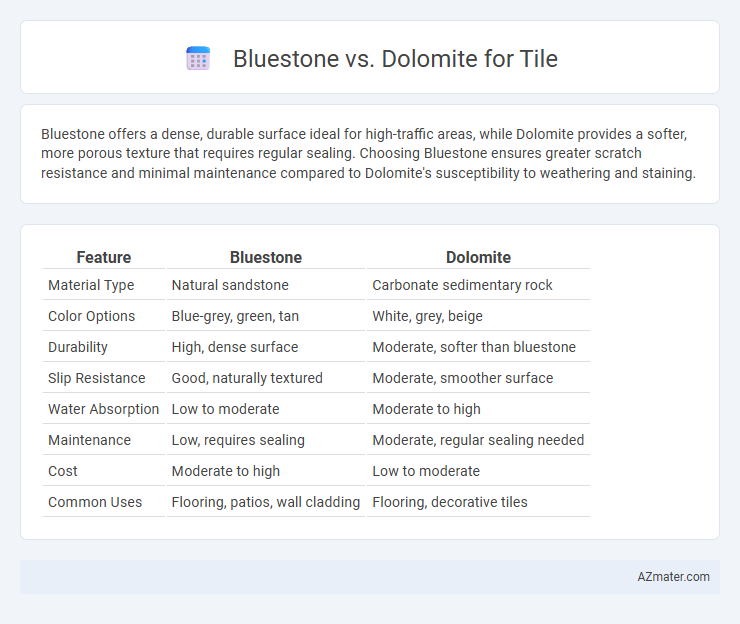Bluestone offers a dense, durable surface ideal for high-traffic areas, while Dolomite provides a softer, more porous texture that requires regular sealing. Choosing Bluestone ensures greater scratch resistance and minimal maintenance compared to Dolomite's susceptibility to weathering and staining.
Table of Comparison
| Feature | Bluestone | Dolomite |
|---|---|---|
| Material Type | Natural sandstone | Carbonate sedimentary rock |
| Color Options | Blue-grey, green, tan | White, grey, beige |
| Durability | High, dense surface | Moderate, softer than bluestone |
| Slip Resistance | Good, naturally textured | Moderate, smoother surface |
| Water Absorption | Low to moderate | Moderate to high |
| Maintenance | Low, requires sealing | Moderate, regular sealing needed |
| Cost | Moderate to high | Low to moderate |
| Common Uses | Flooring, patios, wall cladding | Flooring, decorative tiles |
Overview of Bluestone and Dolomite
Bluestone is a dense, durable natural stone commonly used for flooring and outdoor tiles, prized for its rich blue-gray hues and slip-resistant surface. Dolomite, composed mainly of calcium magnesium carbonate, offers a smoother texture and lighter shades, often cream to light gray, making it suitable for indoor tile applications. Both stones provide distinct aesthetic and functional benefits, with bluestone favored for high-traffic and exterior environments while dolomite is preferred for polished, decorative indoor flooring.
Geological Origins and Composition
Bluestone is a dense, fine-grained sandstone primarily composed of quartz and feldspar, formed through sedimentary processes in ancient riverbeds and ocean floors. Dolomite is a carbonate rock composed mainly of the mineral dolomite (calcium magnesium carbonate), created through the alteration of limestone by magnesium-rich fluids during diagenesis. The difference in geological origins and mineral composition impacts their durability, porosity, and suitability for tile applications.
Appearance and Aesthetic Qualities
Bluestone exhibits a rich, deep blue-gray color with subtle veining that adds natural elegance and sophistication to tile surfaces. Dolomite, often lighter in tone ranging from cream to beige, offers a more uniform texture with occasional fossilized patterns that enhance its classic and timeless appeal. The choice between Bluestone and Dolomite tiles significantly impacts the overall ambiance, with Bluestone providing a modern, striking aesthetic and Dolomite delivering a warm, understated charm.
Durability and Strength Comparison
Bluestone offers moderate durability with a density that provides good resistance to wear and weathering, making it suitable for indoor and light outdoor tile applications. Dolomite features a harder crystalline structure and higher compressive strength, resulting in superior durability and resistance to chipping or cracking under heavy foot traffic. The mineral composition of dolomite enhances its ability to withstand extreme conditions, positioning it as the stronger choice for high-traffic or exterior tile installations.
Slip Resistance and Surface Texture
Bluestone offers excellent slip resistance due to its naturally rough, cleft surface texture, making it ideal for wet or high-traffic areas. Dolomite tends to have a smoother, more polished finish, which can be more slippery when wet and may require additional treatment to improve traction. Selecting Bluestone for tile applications enhances safety and durability with its coarse grain providing superior grip compared to the softer, finer texture of Dolomite.
Suitability for Indoor and Outdoor Use
Bluestone offers exceptional durability and slip resistance, making it ideal for both indoor flooring and exterior applications such as patios and walkways. Dolomite features a smooth, polished surface better suited for indoor tiles in low-traffic areas, as it is less resistant to weathering and abrasion. For outdoor use, bluestone withstands freeze-thaw cycles and heavy foot traffic, while dolomite requires protective treatments to maintain its appearance.
Maintenance and Cleaning Requirements
Bluestone tiles require regular sealing and gentle cleaning with pH-neutral cleaners to prevent staining and maintain their natural appearance, as their porous surface can absorb moisture and dirt. Dolomite tiles offer higher durability and lower porosity, making them more resistant to staining and easier to clean with mild detergents, reducing maintenance frequency. Both materials benefit from prompt spill cleanup, but dolomite's hardness and density generally result in less frequent sealing and maintenance needs compared to bluestone.
Cost and Value Analysis
Bluestone tiles typically range from $7 to $15 per square foot, offering durability and a natural, earthy appearance that adds long-term value to flooring projects. Dolomite tiles generally cost between $5 and $12 per square foot, providing a budget-friendly option with moderate hardness and resistance to wear. Evaluating cost versus value, bluestone presents a higher upfront investment but greater durability and aesthetic appeal, while dolomite suits cost-conscious projects targeting functional and decorative balance.
Environmental Impact and Sustainability
Bluestone is a natural stone known for its durability and low environmental impact due to minimal quarrying waste and the ability to source it locally, reducing transportation emissions. Dolomite, while also natural, often requires more intensive extraction processes that can result in greater habitat disruption and higher carbon emissions. Choosing bluestone for tile applications generally supports sustainability goals through longer lifespan and lower embodied energy compared to dolomite-based options.
Pros and Cons: Bluestone vs Dolomite for Tile
Bluestone offers exceptional durability and natural slip resistance, making it ideal for high-traffic areas and outdoor tiles, but it can be prone to staining and requires regular sealing. Dolomite features a smooth, polished finish with higher resistance to acid and scratching, suitable for indoor decorative tiles, though it is softer and less suitable for heavy wear areas. Choosing Bluestone or Dolomite depends on the specific application demands related to durability, maintenance, and aesthetic preference.

Infographic: Bluestone vs Dolomite for Tile
 azmater.com
azmater.com